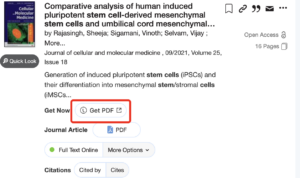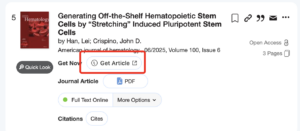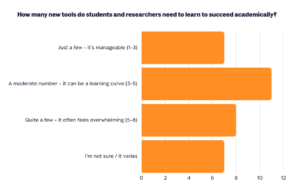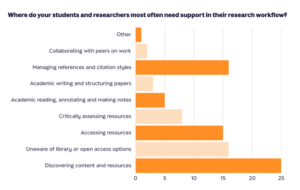We are thrilled to announce the initial launch of Lean Library‘s One-Click to PDF feature, with the next phase launching later this year. The initial launch offers users one-click access to the full-text PDF of academic content via a widget on the library’s discovery layer — without requiring users to download the Lean Library browser extension.
Read on to learn everything you need to know about this exciting development, what’s coming in the next phased release, and how it benefits librarians, students and researchers.
Accessing library-subscribed scholarly resources has long been a challenge for researchers and students, especially as the majority of content discovery starts outside the library environment. When searching for content online, it can take students and researchers an average of 12 clicks to reach a full-text PDF of an article, costing them valuable time.
Lean Library is a trusted tool in streamlining access to library resources and delivering library services directly to users in their online workflows through its browser extension. Lean Library previously saved users up to 3 minutes per content search by streamlining authentication and access to library-subscribed content on publisher sites, where users then click to the desired content.
While this remains at the core of Lean Library’s offering, the new One-Click to PDF feature expands on this by instead taking users direct to the full-text article PDF (or HTML equivalent) in just one click. Furthermore, it does this without the need for the browser extension via a ‘Get PDF’ widget that can be injected on the library discovery system.
As a pioneer in access solutions for libraries, this development underscores Lean Library’s commitment to enhancing the visibility and usage of library resources. Whether through the trusted browser extension or the new ‘Get PDF’ widget, Lean Library removes barriers to knowledge by streamlining academic workflows and strengthening the library’s central role in supporting students and researchers.
This initial launch provides Lean Library customer institutions with an injectable ‘Get PDF’ widget to embed on their library discovery layer. The widget is powered by an integration with GetFTR, which ensures high-quality and reliable linking with all major publisher content. It detects in real-time where an article PDF is available and displays a ‘Get PDF’ button that instantly downloads the article PDF for users in just one click. If a PDF isn’t available, users instead see a ‘Get Article’ button, which takes them to the publisher’s HTML version or landing page as the next best option.
This streamlines content discovery for students and researchers and saves them time from having to navigate between library discovery layers and publisher sites to get their hands on the actual full-text.
Get PDF button example:

Get article button example:

The widget is initially available for Ex Libris Primo and Summon library discovery services. It will next support OCLC Worldcat and EBSCO EDS. Customer librarians will be able to access engagement metrics on click-through rates and successful downloads via the Lean Library dashboard shortly after launch.
While the integration with GetFTR offers reliable PDF linking for all major publisher content, we plan to rapidly expand content coverage in the next phases of development. In addition, the ‘One-Click to PDF’ button will be made available within the Lean Library browser extension to streamline workflows of students and researchers who bypass the library discovery layer entirely and who prefer to start their content discovery online. Furthermore, we are looking to extend this to multi-search platforms like Google Scholar for the button to appear next to academic content in users’ search results — ultimately to meet students and researchers in their different preferred workflows.
As Lean Library continues to grow and develop, we remain committed to streamlining the research experience by amplifying the value of academic libraries. If your institution wants to learn about, contact us.
From Tool Overload to Seamless Research: Lean Library Workspace May 21, 2025We recently hosted a webinar introducing Lean Library Workspace—the latest development in our mission to redefine and amplify the power of the academic library to advance teaching, learning and research. Lean Library Workspace transforms Lean Library into the ultimate end-to-end research tool.
Library professionals from around the world joined us, sharing their experiences, challenges and perspectives. Through polls and discussion, one message was clear: students and researchers are expected to navigate too many tools and libraries need to provide more streamlined and integrated support.
Lean Library Workspace takes the library and its users beyond the access, discovery and guidance part of the research workflow that Lean Library currently supports, through to reference management, project collaboration and authoring work. It connects the browser extension to a new Lean Library Workspace website and accompanying Google Docs and Word plug-ins.

One of the strongest themes to emerge from our webinar polls was tool fatigue. Students and researchers are often expected to juggle multiple platforms—one for access, another for reference management, a third for collaboration, and so on.
When we asked, “How many new tools do students and researchers need to learn to succeed academically?”, most respondents said between three to eight. That’s a steep learning curve, especially for new students. And it often leads to confusion about what the library supports, or where to go for help.
This underlines the value of an all-in-one tool like Lean Library Workspace—one that simplifies the research journey by bringing together discovery, access, citation, collaboration, and authoring into one seamless tool. The result? A more focused, less fragmented experience, helping students and researchers focus on their work rather than struggling to manage multiple tools and platforms.

Libraries are already doing a great deal to support research skills through:
But even with this support, users often remain unaware of what resources and services are available through the library or how to access them. Lean Library helps bridge this gap by delivering support at their point of need—whether on Google Scholar, Wikipedia, or even ChatGPT.

📌Tip: Take advantage of Lean Library’s promotional toolkit—including a Lean Library Workspace LibGuide, videos, flyers, and more—to help build awareness of Lean Library on campus. Group deployment is also available and can increases engagement significantly.
Our polls uncovered key gaps in current library offerings:
This highlights a growing need for tools that work across the entire research workflow—just like Lean Library Workspace does.
When we asked, “Where do your students and researchers most often need support in their research workflow?”, responses consistently highlighted a few key areas:
These challenges reflect the complex nature of the modern researcher workflow. Lean Library supports users in each of these areas without requiring them to leave their workflow or learn yet another platform.

According to attendees, an all-in-one tool like Lean Library Workspace could offer a wide range of benefits, including:
With our librarian dashboard, Lean Library Workspace also equips libraries with valuable analytics to inform decision-making and demonstrate the library’s impact.
The answer: everyone! According to poll respondents, undergraduate students, postgraduate researchers, faculty, and librarians all stand to gain from a tool like Lean Library Workspace.
It simplifies the research journey, increases efficiency, boosts productivity, saves money and time, drives usage of resources, and brings more visibility to the library.
“I love it more than Papers and EndNote. It’s intuitive, quick, and easy.”
— Ernesto Perez, Postdoctoral Fellow, NIH
“The best scholarly tool I’ve seen so far in terms of its practical usage!”
— Shervin Safavi, PhD student, Max Planck Institute
Lean Library Workspace isn’t just another tool. It’s a direct response to the increasing complexity of today’s digital research workflows. It removes the challenges of jumping between platforms and brings your library’s resources and service into a single user-friendly experience.
Lean Library puts the library at the heart of every research journey. Providing an uninterrupted research rhythm to your users. Stop requiring students and researchers to find the library—let the library come to them.
Interested in a personalised demo? Request one here or email us at info@technologyfromsage.com.
🔗 Explore Lean Library Workspace today: workspace.leanlibrary.com
Lean Library in 2024: Growing Our Community December 19, 2024Academic libraries are in a transformative period, with the rise of Artificial Intelligence and Open Access driving dramatic changes in user behaviour, discovery workflows and publishing models. Lean Library was originally created by librarians, for librarians, to support them in this transformation by embedding library content and resources in user online workflows via an app on their browser – whether are on Google, PubMed, ChatGPT or beyond.
With librarians at the heart of Technology from Sage’s strategy and values, fostering and growing the community of libraries that use Lean Library is as important as the product innovations and developments we make (psst read about those developments here). As the year draws to a close, it’s the perfect time to reflect on the growing Lean Library community, and how libraries are utilizing Lean Library to support student success and mental health, provide more equitable access to off-campus students, and more.
In this blog, we delve into Lean Library’s community highlights of 2024, including feedback from the student and researcher users that Lean Library ultimately benefits.
This year, we were delighted to welcome many new institutions on board with Lean Library from around the world to support their different library strategies. Auburn University Libraries implemented Lean Library to enhance library discovery and support their commitment to provide exceptional student-centered experiences and impactful research by faculty. Similarly, Oral Roberts University adopted Lean Library to help combat student stress, which can be brought on by the overwhelm of new academic tools and skills they need to learn.
Lean Library also welcomed the University of Leeds as a new partner in the UK. Like Auburn University and Oral Roberts University, the University of Leeds is taking all the power of their library into online workflows with Lean Library’s premium ‘Futures’ features.
In 2024, universities continued to improve student success and boost research output with Lean Library. Below we share some inspiring success stories of what institutions achieved with Lean Library this year:
Samford began promoting Lean Library to its campus in August 2024 to enhance resource discoverability, inspired by positive testimonials from other libraries. Lean Library connects Samford students to the university’s extensive digital collections through content integration and personalized notifications. Lean Library allows Samford to set up keywords that link directly from popular web pages like Wikipedia and Google Scholar to their special collections, boosting discovery and usage. Since launching in August, Samford saw a nearly 200% increase in engaged users and saved students nearly 450 hours by streamlining access to resources. Read more about Samford University’s story here.
Vrije Universiteit combines Lean Library and Talis to complement each other, creating a more efficient system. By implementing Lean Library, VU streamlined access to enhance the use of open educational resources and library holdings, resulting in cost savings and improved user satisfaction. This approach has influenced how lecturers design their courses. The recommended workflow involves lecturers having Lean Library installed in their browsers, so when searching for content online, it directs them to materials already available through the library’s WMS/OCLC system, providing a clear overview of accessible resources to add to their reading lists. Read more here.
The University of Hertfordshire saw outstanding success after introducing Lean Library, achieving an over 2,000% increase in engaged users within just three months. Through a range of targeted promotional strategies, the university drove the adoption of Lean Library and achieved impressive outcomes, including streamlining access to library resources nearly 80k times and a nearly 50% increase in interlibrary loans, with 17% directly attributed to Lean Library.
While Lean Library is a library solution, it ultimately benefits the students, researchers and other patrons who the library serves. Students and researchers are strapped for time and overwhelmed by the number of academic tools they need to learn. Lean Library helps reduce this overwhelm as an easy-to-use tool that streamlines the research journey, offering the best user experience. Below we share snippets from what our users say about Lean Library.
2024 has been an exciting year for Lean Library, filled with webinars, conferences, and events that brought librarians together from all over the world – from the United States to Europe to Australia.
This year, we were thrilled to host the Technology from Sage APAC Insight event at the University of Queensland in Australia. Over two days, thirty members of the academic community gathered to dive into important librarian topics, with a special focus on AI, including a workshop and lively discussions.
If this sounds interesting to you for 2025, be sure to register here!
Our 2024 webinar series brought in some amazing guest speakers and sparked great conversations. Here are the top 5 webinars of the year that really stood out:
In 2024, Technology from Sage sponsored conferences around the world to connect with academic libraries, hear about their challenges and opportunities – and always give away our Lean Library Llama mascot prize to winning librarians.
As we wrap up 2024, the Lean Library team would like to extend our heartfelt thanks to our university partners for a fantastic year. We’re excited to continue connecting libraries with their users in 2025 and beyond.
If your library would like to increase usage of library resources, boost the visibility of your library or want to embrace a more patron-centric approach, request a demo today.
